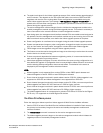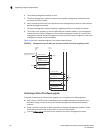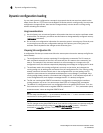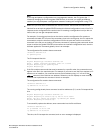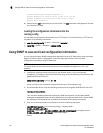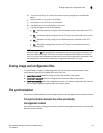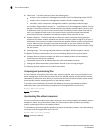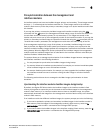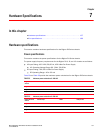
150 Brocade BigIron RX Series Hardware Installation Guide
53-1002483-03
Using SNMP to save and load configuration information
6
BigIron RX(config)# interface ethernet 3/1
BigIron RX(config-if-e1000-3/1)# no ip add 10.10.10.1/24
BigIron RX(config-if-e1000-3/1)# ip add 10.10.10.69/24
BigIron RX-if-e1000-3/1)
• Always use the end command at the end of the file. The end command must appear on the last
line of the file, by itself.
Loading the configuration information into the
running-config
You can load the configuration information from a TFTP server. To load the file from a TFTP server,
use either of the following commands:
• copy tftp running-config <ip-addr> <filename> [overwrite]
• ncopy tftp <ip-addr> <filename> running-config
Using SNMP to save and load configuration information
You can use a third-party SNMP management application such as HP OpenView to save and load a
BigIron RX Series switch’s configuration. Follow the steps given below to save and load
configuration information using HP OpenView.
NOTE
The syntax shown in this section assumes that you have installed HP OpenView in the “/usr”
directory.
1. Configure a read-write community string on the Brocade device, if one is not already
configured. To configure a read-write community string, enter the following command from the
global CONFIG level of the CLI:
snmp-server community <string> ro | rw
where <string> is the community string and can be up to 32 characters long.
2. On the Brocade device, enter the following command from the global CONFIG level of the CLI:
no snmp-server pw-check
This command disables password checking for SNMP set requests. If a third-party SNMP
management application does not add a password to the password field when it sends SNMP
set requests to a Brocade device, by default the Brocade device rejects the request.
3. From the command prompt in the UNIX shell, enter the following command:
/usr/OV/bin/snmpset -c <rw-community-string> <device-ip-addr>
1.3.6.1.4.1.1991.1.1.2.1.5.0
ipaddress <tftp-ip-addr> 1.3.6.1.4.1.1991.1.1.2.1.8.0 octetstringascii <config-file-name>
1.3.6.1.4.1.1991.1.1.2.1.9.0 integer <command-integer>
where:




